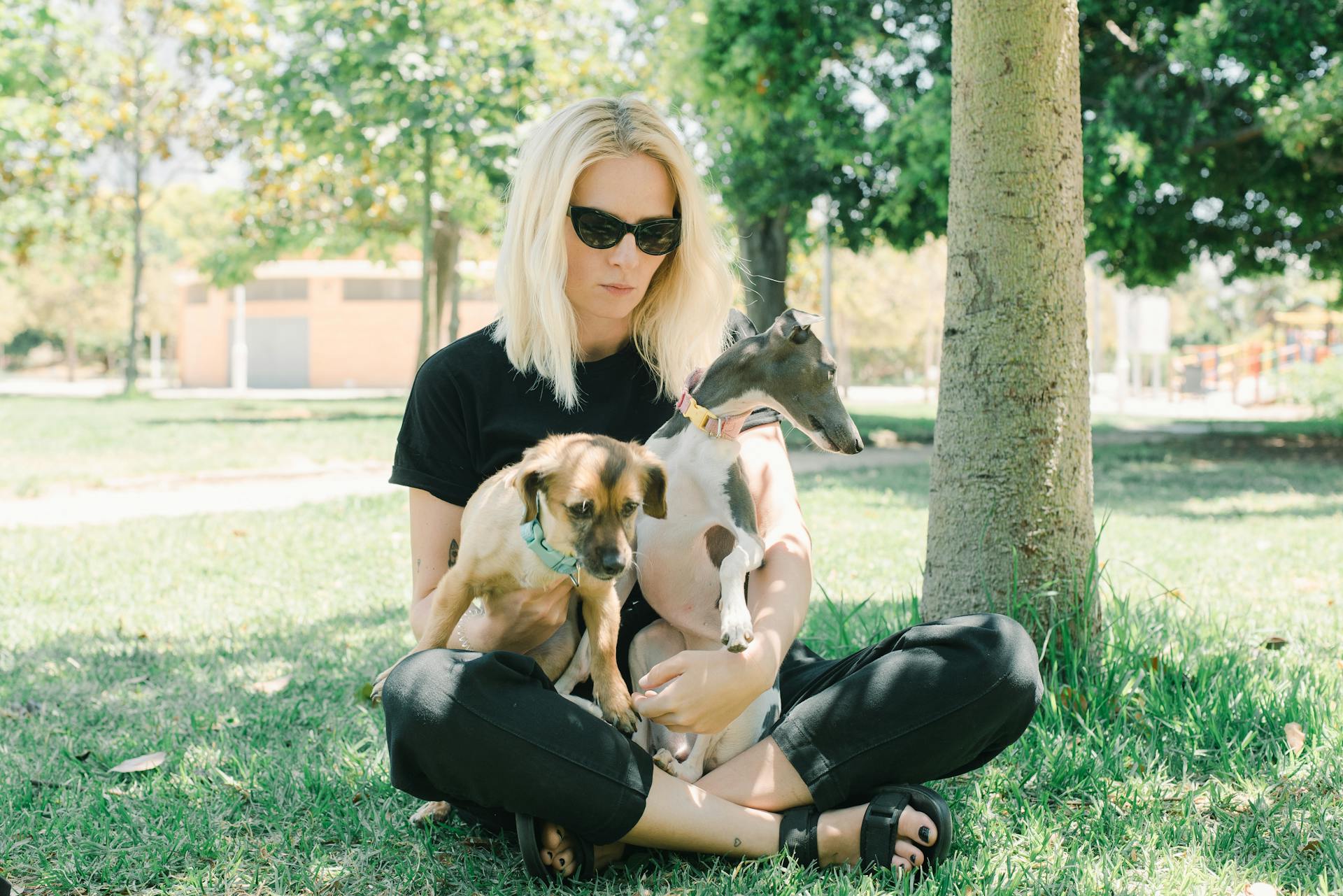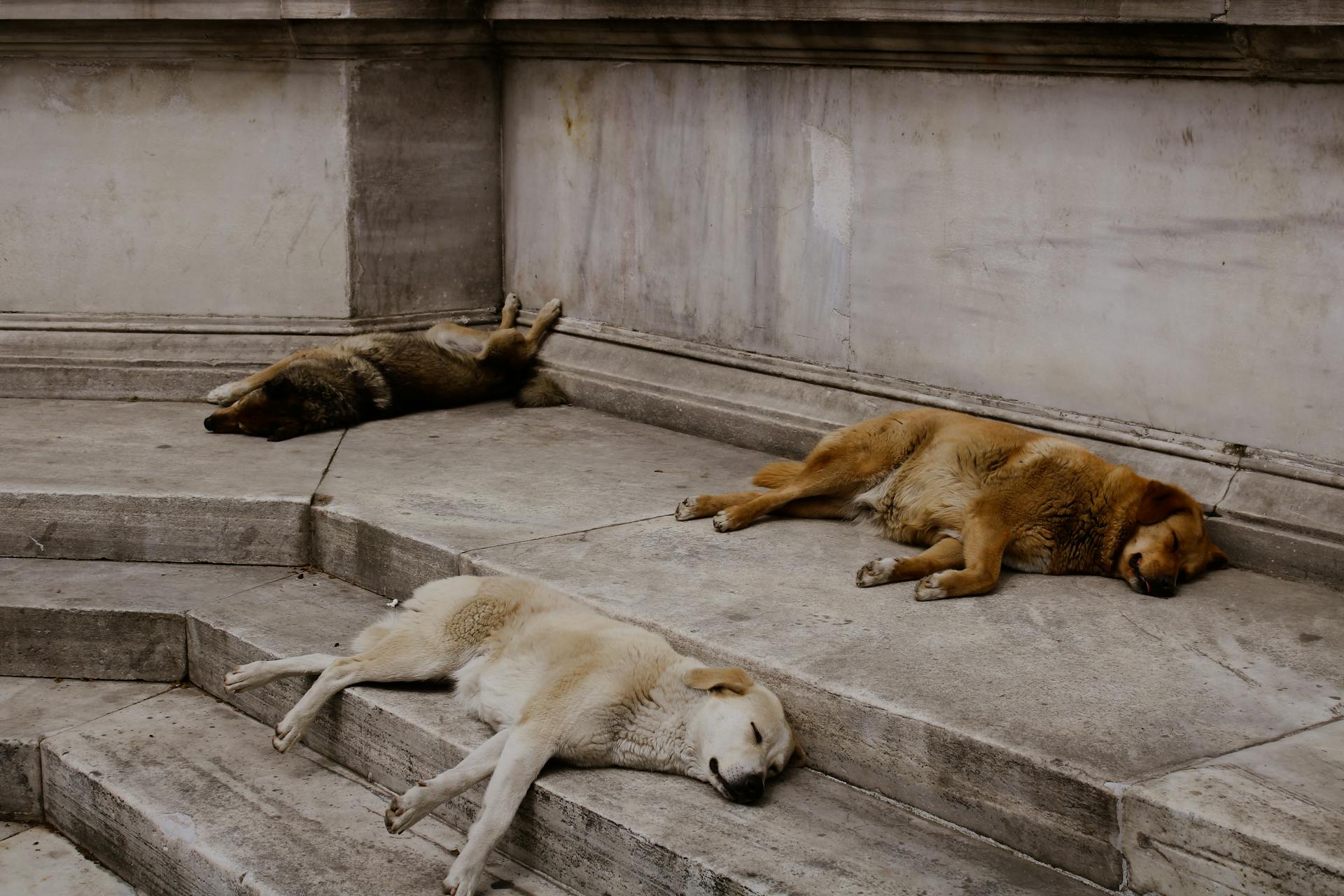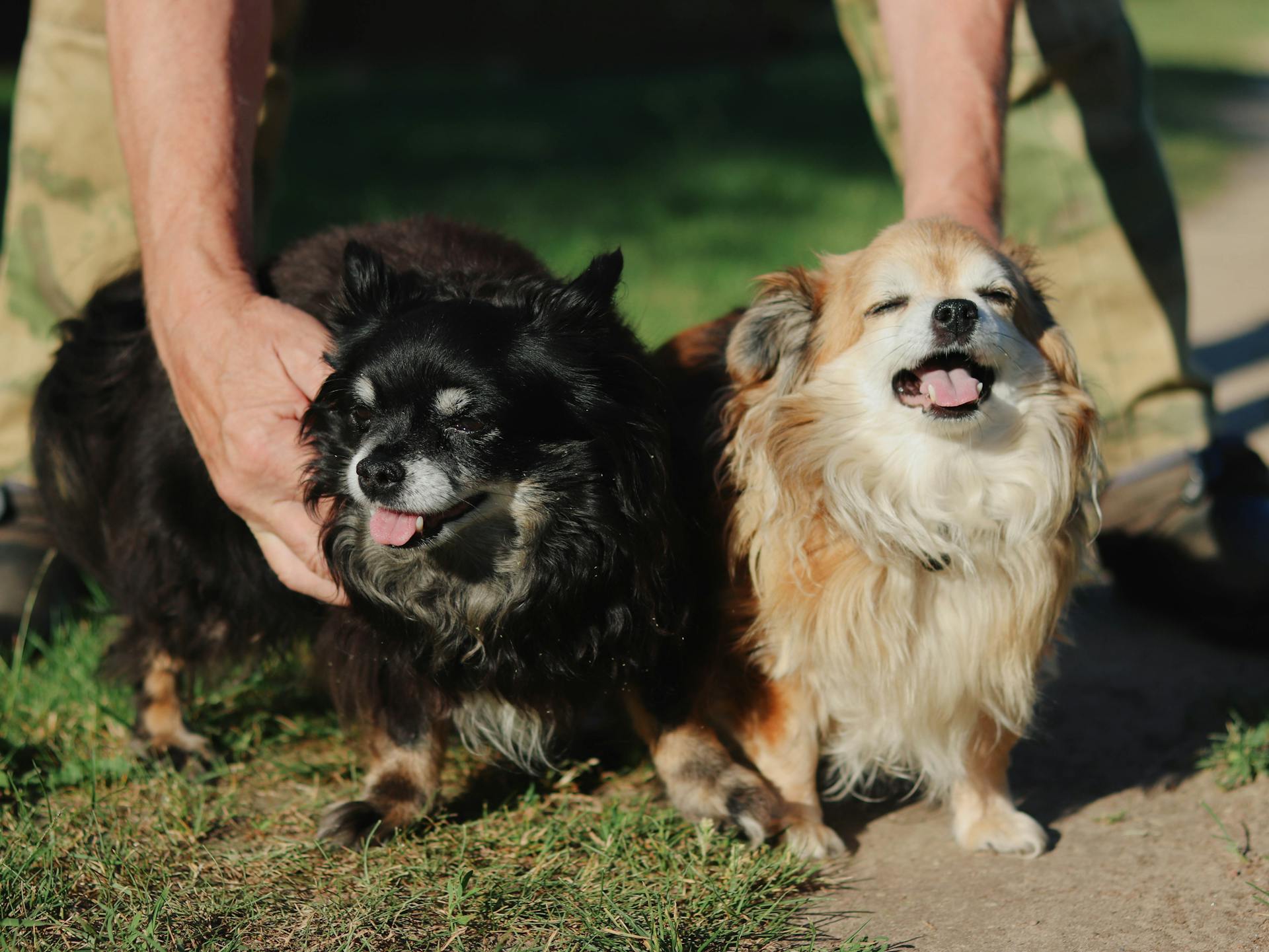
Dogs need water to stay hydrated, but sometimes they just don't drink enough.
A dog's water intake should be at least 1 ounce of water per pound of body weight per day.
Dogs that don't drink enough water can get dehydrated, which can lead to serious health problems.
Some dogs may not drink enough water due to medical conditions, such as kidney disease or diabetes.
Why Dogs Need Water
Dogs need water to facilitate their metabolic processes, which includes digestion, brain activity, blood flow, and breathing. Without water, these essential functions can't happen, potentially harming vital organs.
Water makes up most of your dog's blood, and as it flows through their body, it clears toxins and transports oxygen.
Water helps regulate your dog's body temperature, especially in hot weather when they pant to cool down. Panting releases water through evaporation, but they may need to drink more water than usual to compensate.
Healthy dogs don't drink enough water due to common reasons, but it's not because they're desert creatures - it's usually something simpler.
Factors Affecting Water Intake
Dogs' diets play a significant role in their hydration levels. Fresh food retains moisture, but kibble, which is processed and dried, does not. This can make it harder for dogs on a dry diet to stay hydrated.
Fresh snacks like fruit can help dogs stay hydrated, especially if they're on a fresh diet. The natural moisture in these foods can contribute to their overall water intake.
Monitoring water intake is crucial, especially when your dog is not feeling well. The body needs more fluids on days like these, and knowing how to check for dehydration signs can help you take precautions.
Activity Level
A dog's activity level can greatly impact their water intake. If your dog has just gone on a big walk on a hot, sunny day, they'll likely rush straight for the water bowl upon returning home.
Their body temperature and energy levels will also play a role. If your dog isn't particularly active, but then exerts themselves more than usual, they'll tire themselves out more quickly and get more thirsty.
It's essential to monitor your dog's activity level and provide them with more frequent water breaks accordingly. This can help prevent dehydration and ensure they stay hydrated throughout the day.
Expand your knowledge: How Much Water Should Dogs Have a Day
Diet

A dog's diet can have a significant impact on their hydration levels. A fresh diet that includes fresh food and snacks like fruit can provide natural moisture, making it easier for your dog to stay hydrated.
If your dog eats a diet high in sodium, they may experience a sudden increase in thirst. This is because their body is trying to compensate for the excess salt.
Dry food, on the other hand, can lead to a high water intake because it lacks the moisture found in fresh food.
Consider Seasonal Changes
Consider seasonal changes when thinking about your dog's hydration. In the winter, lower humidity and dry air can make your pup feel dry and thirsty.
You might think hot summer sun is the only time your dog needs extra hydration attention, but it's not. In the colder months, a warm dish of dog-friendly bone broth can help keep your pup hydrated. Bone broth contains vitamins, minerals, and even some protein.
Having fresh, cool water available to your pup is always a good idea, but bone broth can be a helpful supplement during the winter. It's a great choice for pups who might be stressed by the cold weather.
Increasing Water Availability
Increasing water availability is key to getting your dog to drink more water. You can achieve this by placing water bowls in several places around the house, including outdoors for when your dog is outside soaking up the sun.
Having at least three bowls of fresh water available in several rooms will encourage your dog to drink whenever it's thirsty. The right-sized bowl is also essential, as an adult Labrador would struggle to drink out of a bowl meant for a Yorkie.
Putting water bowls all over the house will make it more convenient for your dog to drink, and don't forget to get bigger bowls that can hold at least a quart of water to meet your dog's daily hydration needs.
At Home
Placing water bowls in several places around the house ensures your dog has access to water in whatever room they're in. This is especially important for dogs that like to lounge around the house.
Additional reading: Dog House

A bowl or two outdoors is also a good idea, especially on sunny days when your dog might be spending more time outside. This way, they can stay hydrated even when they're soaking up the sun.
The right-sized bowl is crucial for making drinking more manageable and convenient for your dog. An adult Labrador, for instance, would struggle to drink out of a bowl meant for a Yorkie.
Intriguing read: Why Does My Dog Get Mad When I Sniff Him?
Always Accessible
Having water available at all times is crucial, especially for dogs that don't like drinking from bowls. Try placing water bowls in several rooms around the house, including outdoor areas where your dog spends time.
Dogs will only drink water when they're thirsty and can find it nearby, so having multiple bowls is essential. Aim for at least three bowls of fresh water in different rooms.
If your dog is under the weather, it's even more important to encourage it to drink water by hand. Offering a drink by hand can make a big difference in getting your dog to drink more water and helping its system get rid of symptoms.

When you're out with your dog, take breaks every 10 to 20 minutes to offer it water. This will help ensure your dog stays hydrated, especially on hot days or during long walks.
Remember, the size of the bowl matters too. Choose a bowl that can hold at least a quart of water, especially if you have a large or active dog that needs more water.
You might enjoy: Why Is My Dog's Water Bowl Slimy?
Monitoring and Maintaining Hydration
Monitoring your dog's water intake is crucial, especially when they're not feeling well. They need even more fluids on days like these.
You can track how much your pup drinks by checking their water bowl throughout the day. If you can't track their intake, look for dehydration signs like dry gums and sticky mouth.
A good rule of thumb is to give your dog one ounce of water per pound of body weight per day. For example, a 20-pound German shepherd should drink around 20 ounces of fluids a day.
Signs of Dehydration
Dehydration can sneak up on your furry friend, but there are some telltale signs to look out for. A dry nose is a clear indicator of dehydration in dogs.
Panting is another common sign, as dogs try to cool themselves down. Fatigue is also a warning sign, as dehydration can lead to a lack of energy.
Dry gums are another indicator of dehydration, and you can check for this by gently pressing your finger against your dog's gum. If it feels dry or sticky, it's a sign that your dog needs more water.
You can also check for dehydration by gently grabbing some skin on your dog's back and releasing it. If the skin takes longer to return to its original position, it's a sign of dehydration.
Here are some tests you can do quickly to check for dehydration:
- Grab the scruff of your puppy's neck gently, stretch it out, and then let go. The skin should snap right back into place. If it's slow to snap back, your dog is dehydrated.
- Feel their gums. If they're dry or sticky, they need more water.
- Press your finger gently against their gums, which temporarily blocks the flow of blood. While you're pressing their gums, the area will turn white. When you release the pressure, the area should return to a healthy pink within two seconds. If it takes longer, your puppy is dehydrated.
Monitor Levels
Monitoring your dog's water intake is crucial, especially when they're not feeling well. They need even more fluids on days like these.
If you can't track how much your pup drank during the day, check for dehydration signs to take precautions. This will help you catch any issues early on.
A dog's water intake can be affected by their activity level. If they've been on a big walk on a hot day, they'll likely drink a lot of water when they get home. Conversely, if they're not active, they might not drink as much.
The general rule of thumb is to give your dog one ounce of water per pound of body weight per day. This means a 20-pound dog should drink around 20 ounces of fluids a day.
Special Considerations
Dogs with medical conditions, such as diabetes or kidney disease, may have increased water needs. Their owners should closely monitor their water intake and report any changes to their veterinarian.
Senior dogs and those with sensory loss, dementia, or chronic arthritis may have difficulty accessing or remembering to drink water. Their owners should ensure they have easy access to fresh water at reliable locations or times.
Fresh food diets, like those offered by Ollie, can help increase moisture in a dog's diet. This can be particularly beneficial for dogs who have trouble drinking enough water.
Why Are Puppies Important?
Puppies are tiny balls of energy and love, and they bring so much joy to our lives. They need water to regulate their body temperature, especially in hot weather when they pant to cool down.
Their bodies are mostly made up of water, which is essential for their metabolic processes, including digestion, brain activity, blood flow, and breathing. Without water, their vital organs can be harmed.
Puppies need to drink water to replenish what they lose through panting, so it's crucial to keep an eye on their water intake, especially on hot days.
Explore further: Hot Dog Flavored Water
Pregnancy and Nursing
Pregnant and nursing dogs have an increased need for hydration, just like humans, as they nurture their puppies.
Offer plenty of water to your mama dog, and keep the food bowl away from the water bowl to avoid affecting her water intake if she's picky about certain foods.
Medication
Certain prescription medications can cause dogs to drink more water than usual. Anti-inflammatory and corticosteroid drugs, such as prednisone and prednisolone, are known to increase thirst and water intake in dogs.
These medications are commonly used to treat a range of ailments, including allergies and autoimmune diseases.
Tips for Special-Needs
For special-needs dogs, it's crucial to ensure they have easy access to fresh water at reliable locations or times. Puppies and senior dogs need a little extra care regarding hydration, and senior dogs are at increased risk of dehydration.
Senior dogs suffering from sensory loss, dementia, or chronic arthritis may have difficulty locating or reaching their water bowl. Measuring and recording your dog's water intake can provide helpful insights about their health.
Any sudden changes in your pup's water intake should be discussed with your veterinarian. Water is an essential and simple nutrient for dogs, and any well-meaning pup parent can easily overlook whether their pooch is staying adequately hydrated.
Puppies can be picky about water, and some may go nuts for it. Paying extra attention to your dog's behavior and relationship with water is key to ensuring they're staying hydrated.
What If My Isn't?

If your dog isn't drinking water, it's not always a cause for concern. Just as a dog might drink more water in some ordinary situations, a dog might drink less if the weather cools down or they’re not as active as usual.
Some changes in your dog's environment or routine can also affect their water intake. If you’ve switched from dry to fresh food, or you’re feeding water-rich treats like fresh fruit, that may have an impact on how much they’re drinking in a day.
Dogs have an excellent sense of smell and may be able to perceive a problem with the water that is not evident to you. If your dog won't drink and you've exhausted immediate options like giving them fresh water, contact your vet right away.
A fresh viewpoint: Dogs Drinking
Frequently Asked Questions
How to rehydrate a dog that won't drink?
Encourage your dog to rehydrate by changing their water source, adding a small amount of flavor, or offering ice cubes to make water more appealing. Try these simple tips to get your dog drinking again
What can I flavor my dog's water with?
You can flavor your dog's water with low-sodium chicken stock or dog-safe fruits like blueberries, cucumber, or oranges. Just be sure to remove the infusions before serving to avoid a choking hazard.
Sources
- https://poopail.com/blogs/news/how-to-keep-your-dog-hydrated
- https://www.akc.org/expert-advice/health/puppy-drinking-enough-water/
- https://blog.myollie.com/how-to-get-a-dog-to-drink-water/
- https://www.thefarmersdog.com/digest/how-to-keep-your-dog-hydrated/
- https://www.becopets.com/blogs/news/how-much-water-should-a-dog-drink
Featured Images: pexels.com


